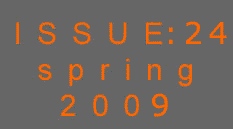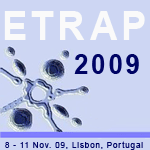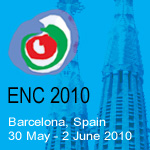
A question of logic

by Andrew Teller
The conclusion of my previous column (no 23 – Winter 2009 issue) introduced a question which was left for examination in this issue of ENS News. Reflecting on the failure of umpteen critics of nuclear energy to take proper account of the intermittency of wind-generated electricity, I asked why such critics are often found overlooking this factor, since it severely, if not fatally, weakens their demonstration that nuclear energy can be easily dispensed with.
Let us ignore the case of those who deliberately brush inconvenient arguments under the carpet so as to concentrate on those who overlook important factors in perfectly good faith. In this context, one is entitled to ask why so many people are not more careful in the fact-gathering phase of their enquiries. My answer to this question is somewhat speculative but I submit that it is worth considering. As it happens, it draws its substance from the province of logic.
We must first recall that nobody enters the nuclear debate with a completely neutral position (my apologies to those who think I’m stating the obvious). When people start making their case, they already know where they are heading to. Let us therefore consider someone whose investigations are influenced by the general feeling that “all Nuclear Power Plants are Bad” or even “all things Nuclear are Bad”, where Bad stands for dangerous, useless, too expensive, you name it. Using N and B as shorthand for the two parts of the sentences separated by “are”, the logical structure of the above-mentioned statement is: “all N are B”. Let us now call non-N and non-B1 the negation of N and B respectively;
I submit that hasty critics of nuclear energy behave AS IF “all N are B” allowed them to conclude that “all non-N are non-B”.
But such derivation is not correct, as can be seen from figure 1 which illustrates the statements in terms of set theory. In this figure, U is the universe of all sets, containing sets N and B in particular. Set N is assumed by the opponents to nuclear energy to be completely enclosed in set B, which provides the framework needed to ensure that all N are effectively B. Their task then is to ascertain whether the sets so defined do indeed contain elements. As a matter of fact, they are quite happy to point out instances of elements such as (a) (e.g. Chernobyl, Three Mile Island) as a confirmation of the validity of their model. But even if we granted them that nuclear energy cannot be good, it would not allow them to jump to the conclusion that all substitute energy sources (non-N elements) will be such as (c), i.e. devoid of defects (non-B). At least some non-N elements could be such as (b) that is at the same time non-N and B, which confirms that the statement “all non-N are non-B” cannot be deduced from the statement “all N are B”.
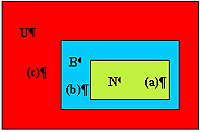 Figure 1
Figure 1 |
(a) |
Nuclear |
Bad |
(b) |
Non-Nuclear |
Bad |
(c) |
Non-Nuclear |
Non-bad |
|
It is of interest to note that the only statement that can be validly deduced from “all N are B” is “all non-B are non-N”, which looks like, but is not the same as, “all non-N are non-B”. The correct derivation expresses the law of contraposition. It can be verified on figure 1 that “all non-B are non-N” refers to the fact that the red region (non-B) is enclosed in the red + blue region (non-N), which can only happen if the yellow region is enclosed in the blue one, i.e. if “all N are B” is true. The only case when “all non-N are non-B” is equivalent to “all non-B are non-N” is when set N and set B are identical. Each and every energy source having its own shortcoming, it is not allowed to assume that these two sets are identical
At the end of the day, three things are needed to reach valid conclusions: a) a set model general enough to handle all possible cases (something like figure 2), b) valid logical derivations and c) proper sampling of the contents of the sets underlying one’s reasoning.
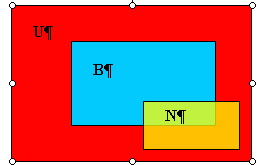
Figure 2
Proper sampling in particular requires that not all attention be devoted to the N set, but that part of it be paid to the non-N part of the model. This is what is routinely dispensed with by hasty critics of nuclear energy. If they had done their homework properly, they would have found out that their proposals all too often fall in the (b) category, and not in the (c) one. Two examples will confirm this conclusion. First, the 2005 Wind Report (available from www.eon-netz.com) underlines the almost negligible contribution of wind machines to guaranteed capacity. It must be noted that this conclusion comes not from an advocate of nuclear energy like me, but from E.ON, a major German utility with a big fleet of wind machines. Second, biofuels that had been touted as an alternative to CO2-emitting fuels now appear to be much less environment-friendly than thought until recently, as reported in a recent issue of The Economist (Biofools, April 11th-17th 2009). In summary, biofuels appear to generate N2O, another greenhouse gas, in quantities sufficient to at least offset the CO2 savings expected. Both undertakings, excessive targets for wind power and biofuels, come to be seen as misallocations of precious resources only made easier by the unwarranted jump from “all that is nuclear is bad” to “all that is non-nuclear is good”.
A lot of discipline is required in order to reach robust conclusions: it is all well and good to pile up arguments against one’s opponent’s views; one must also have the courage of taking a hard look at one’s own preferences. The somewhat unexpected conclusion of all this is that nuclear does not even need to be good to get recognition; all that is needed for it, is not to be worse than the alternatives proposed.
1 It would be more natural to write not-B since non-B actually means “not bad”, but I am following the usual practice in logic for denoting the negation of subjects and predicates.
|

